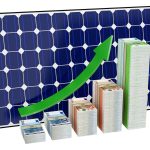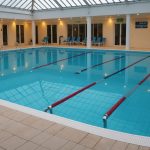Solar energy holds vast potential, especially in the Northern UK, where maximizing efficiency can lead to significant savings and sustainability. Understanding the ideal tilt angles for solar panels is essential for optimizing solar power generation. This guidance helps ensure that your investment yields the best possible returns, adapting to the region's specific sunlight patterns. Explore how these tailored adjustments can enhance the performance of your solar setup and contribute to a greener future.
Understanding Solar Energy in the Northern UK
The potential for solar energy in the Northern UK might seem limited due to its latitude, but advancements in technology have made it a viable option. Despite the region's shorter daylight hours, solar panels can still be effective. The key lies in optimizing solar efficiency by considering several factors.
A lire en complément : Maximizing Solar Thermal Solutions for Hot Water in Your UK Semi-Detached Home
One critical aspect is the tilt angle of solar panels. The angle at which panels are installed can significantly impact their performance. In the Northern UK, where the sun's path is lower, adjusting the tilt angle to capture the maximum amount of sunlight is essential. Panels should ideally be tilted at an angle equal to the latitude of the location to optimize energy capture throughout the year.
Several other factors influence solar energy capture in this region. Weather conditions, such as cloud cover and precipitation, can affect solar efficiency. However, modern solar panels are designed to work efficiently even in less-than-ideal conditions. Technological advancements have improved the ability of panels to capture diffuse sunlight, which is common in the Northern UK.
A découvrir également : How do you choose the right type of solar panels for a UK home with a slate roof?
By understanding these factors and optimizing installation conditions, solar energy can be a practical and sustainable energy source in the Northern UK, contributing to the region's renewable energy goals.
Optimal Tilt Angles for Solar Panels
Determining the ideal tilt angles for solar panels is crucial for maximizing efficiency. The angle not only impacts energy capture but also influences overall solar panel optimization.
General Guidelines for Tilt Angles
For optimal performance, solar panels in the Northern UK should be tilted at an angle approximately equal to the latitude of the location. This general rule ensures that panels capture the maximum sunlight throughout the year. By aligning the tilt angle with the latitude, panels can efficiently harness solar energy even during shorter daylight periods.
Seasonal Adjustments for Maximum Capture
Adjusting the tilt angle seasonally can further enhance solar panel optimization. During summer, a slightly shallower angle can capture more direct sunlight, while in winter, a steeper angle may be beneficial. This flexibility allows panels to adapt to the sun's changing position, maximizing energy capture across different seasons.
Geographic Considerations in the Northern UK
Geography plays a significant role in determining the ideal tilt angles for solar panels. In the Northern UK, where the sun's path is lower, adjusting the tilt to account for unique geographic conditions is essential. Factors such as local topography and potential shading from nearby structures should be considered to optimize solar panel performance in this region.
Seasonal Variations in Solar Radiation
Understanding solar radiation is crucial for optimizing solar panel performance in the Northern UK. Throughout the year, seasonal changes significantly influence the amount of solar energy available.
Analysis of Solar Radiation Patterns
Solar radiation varies with the seasons, affecting the energy output of solar panels. During summer, the sun is higher in the sky, providing more direct sunlight and potentially increasing energy capture. Conversely, in winter, the sun's lower position results in less direct solar radiation, impacting panel efficiency.
Impact of Seasons on Solar Panel Efficiency
The efficiency of solar panels is closely linked to these seasonal variations. In summer, longer daylight hours and increased solar radiation boost energy output. However, during winter, shorter days and reduced sunlight necessitate adjustments to maintain efficiency.
Recommended Tilt Angle Adjustments
To optimise solar panel performance, adjusting the tilt angle according to the season is recommended. In summer, a shallower tilt can enhance energy capture by aligning with the sun's higher path. In winter, a steeper tilt is advisable to maximise exposure to the lower sun. These adjustments ensure that solar panels effectively harness available solar radiation, maintaining optimal energy output throughout the year.
Solar Path Analysis
Understanding the solar path is fundamental for optimizing solar panel installations in the Northern UK. The sun angle and its trajectory influence how much solar energy can be captured, making it essential to consider these factors in solar panel positioning.
Understanding the Sun's Path in the Northern UK
In the Northern UK, the sun angle is relatively low, especially during winter months. This affects the amount of direct sunlight that reaches solar panels. Analyzing the solar path helps identify the optimal positioning to maximize exposure. The sun's path changes with the seasons, and understanding these variations is key to efficient solar energy capture.
Tools and Techniques for Solar Path Analysis
Several tools and techniques can assist in solar path analysis. Solar pathfinders and digital apps can map the sun's trajectory, providing valuable data for solar panel positioning. These tools help visualize potential shading from structures or natural obstacles, ensuring that panels are positioned for maximum sunlight exposure.
Incorporating Solar Path Data into Installation Planning
Integrating solar path data into installation planning enhances solar panel efficiency. By considering the sun angle and trajectory, installers can adjust panel positioning to capture the most sunlight. This strategic approach ensures that solar panels are aligned correctly, optimizing energy capture and improving overall performance.
Fixed vs. Adjustable Mounts
Choosing between fixed mounts and adjustable mounts is crucial for optimizing solar panel systems. Each option has distinct advantages and disadvantages that impact efficiency and cost-effectiveness.
Comparison of Fixed and Adjustable Tilt Mounts
Fixed mounts are set at a permanent angle, typically aligned with the latitude of the location. This simplicity makes them cost-effective and easy to install. However, they may not capture maximum sunlight throughout the year, especially in regions with significant seasonal variations.
In contrast, adjustable mounts offer flexibility. They can be manually or automatically adjusted to follow the sun's path, optimizing energy capture across different seasons. This adaptability can significantly enhance the efficiency of solar panel systems, particularly in areas with varying solar radiation.
Pros and Cons of Each Mounting Option
-
Fixed Mounts:
-
Pros: Lower installation costs, minimal maintenance.
-
Cons: Less efficient in capturing sunlight year-round.
-
Adjustable Mounts:
-
Pros: Increased energy efficiency, adaptable to seasonal changes.
-
Cons: Higher initial costs, potential for increased maintenance.
Cost-Effectiveness and Efficiency Considerations
While fixed mounts are budget-friendly, adjustable mounts can offer greater long-term savings through improved energy capture. The choice depends on budget constraints and the specific solar conditions of the installation site.
Practical Tips for Homeowners
Navigating solar panel installation can be challenging, but with the right information, homeowners can maximize their energy savings. This guide provides practical insights to help optimize solar energy use.
Steps for Determining Ideal Tilt Angles
For effective solar energy capture, determining the correct tilt angle is crucial. Start by aligning the tilt angle with your location's latitude. This ensures optimal sunlight exposure year-round. Use a solar pathfinder or digital app to assess any potential obstructions like trees or buildings. Adjust angles seasonally for enhanced efficiency—shallow in summer and steeper in winter.
Maintenance Tips for Solar Panels
Regular maintenance is key to sustaining energy savings. Clean panels periodically to remove dust and debris that can block sunlight. Inspect for any damage, especially after severe weather. Ensure connections are secure and free from corrosion. Scheduling professional check-ups annually can prevent potential issues and maintain peak performance.
Common Mistakes to Avoid in Solar Installations
Avoiding common pitfalls can enhance the solar panel installation process. One frequent mistake is neglecting the impact of shading on panel performance. Ensure panels are placed in a location with minimal shade throughout the day. Overlooking local regulations can also lead to complications; always verify compliance with building codes and permits before installation.
Case Studies of Successful Installations
Exploring solar installations in the Northern UK reveals insightful case studies that highlight effective strategies. These examples demonstrate how solar energy can be harnessed efficiently, even in regions with challenging conditions.
Overview of Notable Solar Projects in the Northern UK
Several noteworthy solar installations have emerged in the Northern UK, showcasing innovative approaches. For instance, a project in Northumberland successfully integrated solar panels on a community centre, achieving significant energy savings. Another example is a residential installation in Cumbria, where homeowners utilized advanced technologies to maximize solar energy capture.
Analysis of Effectiveness Based on Tilt Angle Choices
The effectiveness of these solar installations often hinges on the strategic selection of tilt angles. In Northumberland, the community centre optimized its solar panel tilt to align with the latitude, enhancing energy efficiency. Similarly, the Cumbria project adjusted tilt angles seasonally, ensuring optimal sunlight exposure throughout the year.
Lessons Learned from Successful Implementations
From these case studies, several lessons emerge. Key takeaways include the importance of precise tilt angle adjustments and the benefits of leveraging local geographic conditions. These insights underscore the potential for solar energy in the Northern UK, offering valuable guidance for future solar projects in similar environments.
Local Weather Data and Its Impact
Understanding the local weather data is crucial for optimizing solar efficiency in the Northern UK climate. Weather patterns significantly influence the performance of solar panels, and accounting for these variations can enhance energy capture.
Understanding Local Weather Patterns
The Northern UK climate is characterized by frequent cloud cover and precipitation. These conditions can reduce the amount of direct sunlight reaching solar panels. However, modern solar technology is designed to harness diffuse sunlight effectively. By analyzing local weather data, homeowners and installers can identify patterns that may affect solar performance, allowing for strategic planning and adjustments.
Correlation Between Weather and Solar Performance
Weather conditions directly correlate with the solar efficiency of panels. Overcast days may decrease energy output, but panels that are optimized for diffuse sunlight can still perform adequately. Monitoring local weather data helps in predicting energy production and planning energy usage accordingly. This proactive approach ensures that solar systems operate efficiently despite the challenges posed by the Northern UK climate.
Adjusting Tilt Angles Based on Weather Conditions
Adjusting tilt angles in response to weather variations can significantly improve solar efficiency. During periods of frequent cloud cover, a steeper tilt may help capture more diffuse sunlight. By integrating weather data into tilt angle adjustments, solar installations can maintain optimal performance throughout varying climatic conditions.
Visual Aids and Resources
Understanding solar panel tilt angles can be challenging without the right tools. Diagrams and charts are invaluable in visualizing the optimal positioning of solar panels. They provide a clear representation of how tilt angles affect solar energy capture, especially in regions like the Northern UK, where the sun's path is lower.
Recommended Charts and Diagrams
For those planning solar installations, using detailed charts can simplify the process. These visual aids illustrate the sun's trajectory and help determine the best tilt angles for different seasons. Diagrams showing the impact of geographic features, such as hills or buildings, can also guide optimal panel placement.
Additional Resources for Solar Energy Information
To further explore solar energy's potential in the Northern UK, several solar resources are available. Online platforms offer interactive tools and calculators that factor in local weather data, helping users make informed decisions. Additionally, educational websites provide comprehensive guides on maximizing solar panel efficiency, tailored to the unique conditions of the Northern UK. These resources ensure that homeowners and installers have the necessary information to optimize solar energy capture effectively.













